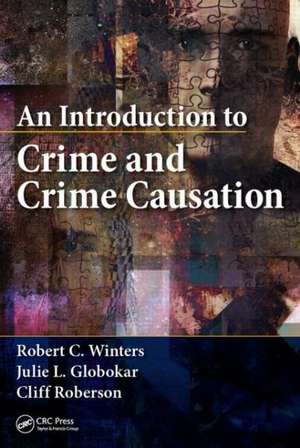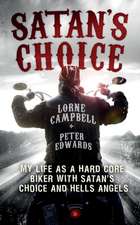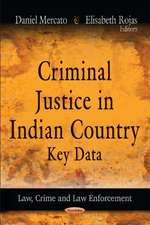An Introduction to Crime and Crime Causation
Autor Robert C. Winters, Julie L. Globokar, Cliff Robersonen Limba Engleză Hardback – 26 iun 2014
Topics covered include:
- The importance of understanding crime data
- The goals of punishment
- The history of criminology, including the influence of social Darwinism on early trait theorists
- Crime causation theories, including a comparison of mainstream and critical theories
- The relationship between crime and biology, including the influence of genetics, substance use, and mental illness
- The social structural approach to crime, including a consideration of the changing contexts of urban criminality
- The nature and function of the justice system at the local, state, and federal levels, and basic categories of crimes
- Drug trafficking crimes, drug court efforts, and perceived weaknesses in current antidrug efforts
| Toate formatele și edițiile | Preț | Express |
|---|---|---|
| Paperback (1) | 354.43 lei 43-57 zile | |
| Taylor & Francis – 30 sep 2020 | 354.43 lei 43-57 zile | |
| Hardback (1) | 1336.94 lei 43-57 zile | |
| Taylor & Francis – 26 iun 2014 | 1336.94 lei 43-57 zile |
Preț: 1336.94 lei
Preț vechi: 1630.42 lei
-18% Nou
Puncte Express: 2005
Preț estimativ în valută:
255.82€ • 267.82$ • 211.68£
255.82€ • 267.82$ • 211.68£
Carte tipărită la comandă
Livrare economică 07-21 aprilie
Preluare comenzi: 021 569.72.76
Specificații
ISBN-13: 9781466597105
ISBN-10: 1466597100
Pagini: 323
Ilustrații: 1 black & white illustrations
Dimensiuni: 178 x 254 x 20 mm
Greutate: 0.74 kg
Ediția:1
Editura: Taylor & Francis
Colecția Routledge
Locul publicării:Oxford, United Kingdom
ISBN-10: 1466597100
Pagini: 323
Ilustrații: 1 black & white illustrations
Dimensiuni: 178 x 254 x 20 mm
Greutate: 0.74 kg
Ediția:1
Editura: Taylor & Francis
Colecția Routledge
Locul publicării:Oxford, United Kingdom
Cuprins
An Introduction to Concepts Involving Crime and Crime Causation. The Concept of Crime. Early Development of Crime Causation Theories. Biological and Psychological Approaches to Crime Causation. Social Structures as a Cause of Crime. Social Process as a Cause of Crime. Integrated Theories. Theories of Critical Criminology. American System of Justice. Criminal Activity: Types, Severity, and Social Impact. Government- and Business-Related Crimes. Drugs and the Justice System. Changing Nature of Crime and Crime Causation.
Notă biografică
Robert Winters is currently a full-time faculty member at Kaplan University. He is a member of the National Criminal Justice Association and serves as a Western Regional Representative, member of the National Advisory Board and its National Elections Committee. He earned his J.D. and B.S. in law degrees at Western State University of Law, Fullerton, California. Robert has taught at Governor’s State University in University Park, Illinois in the areas of crime theory, criminology, and deviance and ethics and for Kaplan University, where he has taught a wide range of courses including criminal law, criminal procedure, and constitutional law.
Julie L. Globokar is an assistant professor of criminology & justice studies at Kent State University, Kent, Ohio. Her work has appeared in the British Journal of Criminology, International Review of Victimology, and Law Enforcement Executive Forum. Her current research examines the social, organizational, and historic factors that shape probation work. Her educational background includes a Ph.D. in criminology, law, and justice from the University of Illinois at Chicago; an M.A. in criminal justice from the University of Illinois at Chicago; and a B.A. in psychology from the University of Wisconsin at Whitewater.
Cliff Roberson is an emeritus professor of criminal justice at Washburn University, Topeka, Kansas. He is also a retired professor of criminology from California State University, Fresno. In 2009, a research study conducted by a group of professors from Sam Houston State University determined that he was the leading criminal justice author in the United States based on his publications and their relevance to the profession [See Southwest Journal of Criminal Justice, Vol. 6, issue 1, 2009]. He has authored or co-authored more than 50 books and texts on legal subjects. His educational background includes a Ph.D. in human behavior from U.S. International University; an L.L.M. in criminal law, criminology, and psychiatry from George Washington University; a J.D. from American University; a B.A. in political science from the University of Missouri; and one year of post-graduate legal study at the University of Virginia School of Law.
Julie L. Globokar is an assistant professor of criminology & justice studies at Kent State University, Kent, Ohio. Her work has appeared in the British Journal of Criminology, International Review of Victimology, and Law Enforcement Executive Forum. Her current research examines the social, organizational, and historic factors that shape probation work. Her educational background includes a Ph.D. in criminology, law, and justice from the University of Illinois at Chicago; an M.A. in criminal justice from the University of Illinois at Chicago; and a B.A. in psychology from the University of Wisconsin at Whitewater.
Cliff Roberson is an emeritus professor of criminal justice at Washburn University, Topeka, Kansas. He is also a retired professor of criminology from California State University, Fresno. In 2009, a research study conducted by a group of professors from Sam Houston State University determined that he was the leading criminal justice author in the United States based on his publications and their relevance to the profession [See Southwest Journal of Criminal Justice, Vol. 6, issue 1, 2009]. He has authored or co-authored more than 50 books and texts on legal subjects. His educational background includes a Ph.D. in human behavior from U.S. International University; an L.L.M. in criminal law, criminology, and psychiatry from George Washington University; a J.D. from American University; a B.A. in political science from the University of Missouri; and one year of post-graduate legal study at the University of Virginia School of Law.
Descriere
A student-friendly textbook that defines and explains the concepts of crime, criminal law, and criminology, this book compares and contrasts early criminal behavior and today's modern forms of crime. It also explores society’s responses to criminal behavior in the past and in the present day. It covers both major and lesser-known crime causation theories and their impact on society. Ideal for a one-semester course, each chapter begins with a set of objectives and concludes with a summary. Interactive questions promote classroom discussion and practicum sections facilitate contextual learning.











